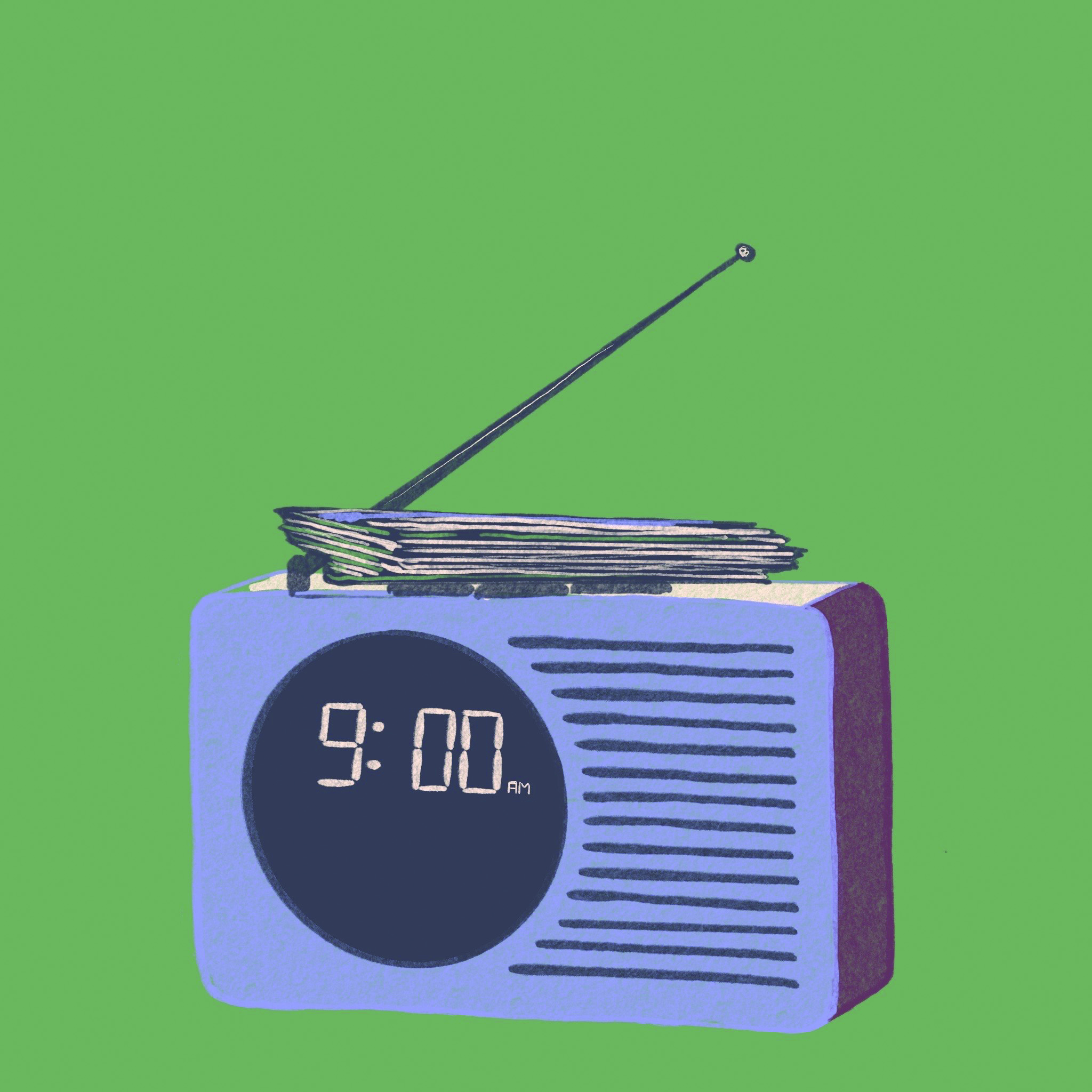Words: meg gray (she/her)
Artwork: Katie Stewart (they/them)
This article features in our third print issue of the year: Ashes to Ashes.
For my birthday this year, I bought myself an alarm radio. I want to make clear that I am no technophobe. Rather, newly 23 and feeling paradoxically less like an adult than ever before, I was compelled instead by melancholic nostalgia. Missing the refuge of my childhood, I sought its soundtrack: the tinny acoustics of a portable radio. Reminiscing being 5 or 6 and crawling into my parents’ bed on weekend mornings as they listened to the musings of a BBC Radio 6 DJ; snow days spent at the kitchen table, eating toast and jam whilst I willed the local station to announce my school’s closure – the radio held a consoling presence that I hadn’t truly appreciated at the time. Reverting to this technology has brought me a lot of joy. Admittedly, with the first few uses, I lacked trust: I would set an alarm on my iPhone in tandem. However, my radio soon became my most reliable possession. A call which gradually increases in volume, I wake now to the sound of music.
Simply, and perhaps indulgently, this little box serves a singular purpose: to wake me up. Unlike the screen of my iPhone which, for an array of tasks, I tap countless times a day, I press the buttons on my radio usually just once: to turn it off before I head out to work or university. Needless to say, none of this is groundbreaking. My radio won’t help me during a power outage or apocalypse, and it certainly hasn’t functioned as a gateway towards a less smartphone-dependent lifestyle either. However, relatedly, there exists a worthy reflection on the material items that take up space in our lives. In his book The Beauty of Everyday Things, Yanagi Sōetsu champions the practical: ‘[Mingei] is devoted to healthy utilitarian purposes. It is, in fact, our most trusty and reliable companion throughout our daily lives. Essentially, it is easy to use and ready at hand, […] provides a sense of ease and comfort, and the more we use it, the more it intimately becomes a part of our lives’. More explicitly interested in modest, handcrafted objects, Yanagi hardly would have considered the mass-produced hunk of plastic that is my radio to be Mingei (indeed, I wonder what he’d make of its faux pine veneer). However, compare it to my iPhone which, despite my reluctance to upgrade, will be replaced, made unusable by an array of forces that benefit from its disposability. Contrastingly sturdy and relatively easy to fix, my radio may well take up a physical presence for the remainder of my life. A steadfast companion, having an object to anchor myself to as I take on life’s early mornings feels radically comforting.
There is no doubt that our boundaries of self and belonging can be grounded in materiality – but where does that leave us in an increasingly digital age? We no longer require so many objects to function sufficiently and, moreover, the objects we now rely upon have simplified our individual output and engagement with the world. Digitalised, our existences are, in many ways, compacted; on a material scale, we become less palpable.
Take the calendar diary. Formed not just by being filled with schedules and reminders, an analog diary becomes representative of our daily lives through the process by which we do so. For instance, variations in handwriting or ink might suggest chronology, urgency, or importance; encompassing doodles and shopping lists (or, antithetically, their scratching out) may signify the corresponding mood to a particular date. Deceivingly simple because of its ease of ability, the analog diary can be endowed with considerable complexity and meaning. As Yanagi has addressed, the pinnacle of expression is the human hand: ‘From its natural movements are born all manner of beauteous things. No machine, no matter how powerful, can match its freedom of movement. […] Without it, beauty would not exist ’. Indeed, streamlined to fit a certain format on the calendar app of our laptops and phones, all individuality is stripped from the logging of daily interactions and pilgrimages. Unable to mediate expressions of self to the same extent as analog processes, I wonder, is the potential originality and creativity of the everyday stunted by digitalism? If yes, are our existences resultantly less physically evident and meaningful?
Just as meditating on everyday actions and procedures is a privilege, so is embracing the tactile ways of interacting with the world without digital filters. Digitalism is complex, and I need not explain how digitisation can make our lives easier – a testament to technology’s usefulness is the reliance humanity has developed upon it during the COVID-19 pandemic and the resultant expedition of attempts to digitise processes and information. Furthermore, considering how the digital preservation of cultural and heritage archives makes them more widely accessible, I will admit that it is short sighted to mourn expressions of existences whilst blaming digitalism. Utilising materiality to confirm to myself (and indeed others) that I exist, perhaps a more worthy reflection is that resurrecting an analog lifestyle is inherently self-centred. Feeling swallowed up by passage of time, why else would I feel the need to make my existence materially evident – to keep a bookshelf of the books I love and dog-ear their pages, to print my photographs and collect postcards, to own a clock radio?
Yanagi Sōetsu, The Beauty of Everyday Things (2019)

